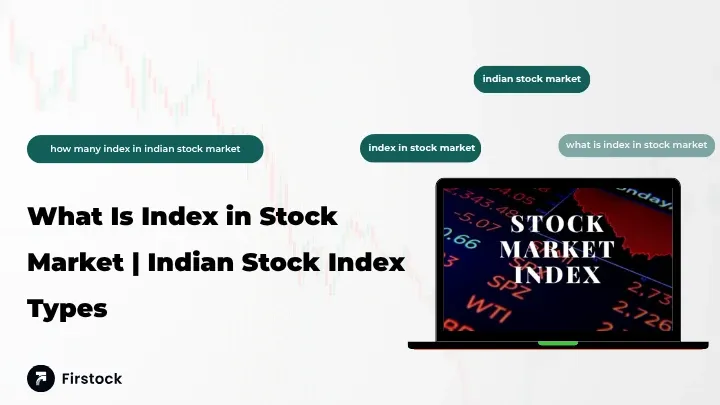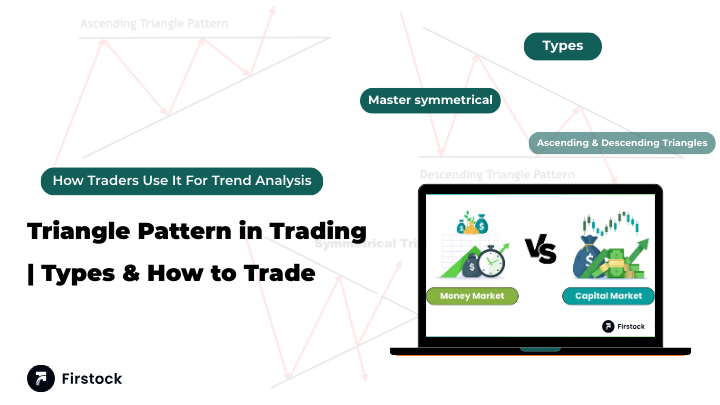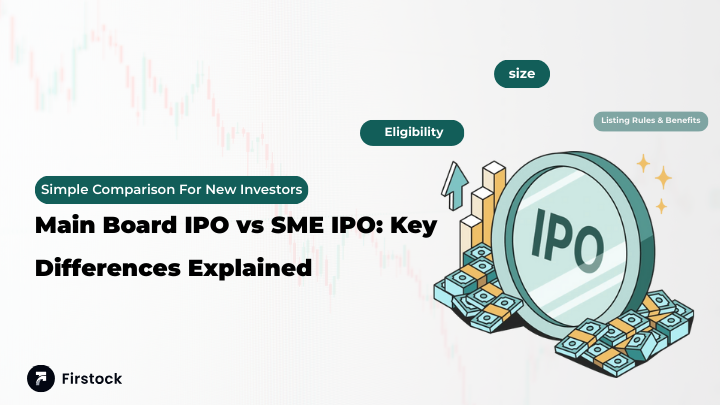What Is Index in Stock Market | Indian Stock Index Types

What Is Index in Stock Market? A Complete Beginner’s Guide
When you watch financial news, you must have come across such statements as "Sensex soared 500 points today!" or "Nifty reached a new all-time high!" But what do these figures actually mean?"
To put it simply, these are the stock market indexes that serve as the main signals of the market's general condition. But beyond just numbers, they act like a mirror showing how India’s economy and top companies are performing.
Let’s break it down — from the basics of what is index in the stock market, to how many index in the Indian stock market exist, and why they matter for both new and experienced investors.
Understanding What Is Index in Stock Market
An index of the stock market is basically a tool that measures the overall performance of a selected group of stocks. It can be compared to a report card for the market which shows the market as a whole whether it is going up, down, or remaining stable.
As an illustration:
The Nifty 50 index comprises the 50 most significant companies listed on the National Stock Exchange (NSE) in terms of market capitalization.
The S&P BSE Sensex index consists of the 30 most valuable companies by market capitalization listed on the Bombay Stock Exchange (BSE) in India.
So, when someone says "Nifty has gone up by 100 points" it essentially means that the average weighted value of those 50 large companies has increased.
In short:
A stock market index = A basket of representative stocks that show how a segment or the entire market is performing.
Why Do Stock Market Indexes Exist?
Indexes help simplify a complex market. With thousands of stocks trading daily, it’s impossible to track each one. An index summarizes the overall direction.
Here’s why they’re important:
Indexes make the market easier to understand — even for someone just starting out.
How Is an Index Created?
You might wonder — with so many companies listed, how do exchanges decide which stocks to include in an index?
Let’s use the National Stock Exchange (NSE) as an example.
The NSE creates an index like Nifty 50 by selecting 50 companies that meet these criteria:
- High market capitalization (big, valuable companies)
- Strong liquidity (frequently traded shares)
- Sector representation (mix of industries like banking, IT, FMCG)
- Consistent financial performance
Each company is assigned a weight based on its market value — so large companies like Reliance Industries or HDFC Bank have a bigger influence on index movements.
When their stock prices rise or fall, the entire index moves accordingly.
How Many Index in Indian Stock Market?
India’s stock market is vast — and so are its indexes.
There are hundreds of indexes, but they can be broadly divided into three types:
1. Broad Market Indexes
These represent the overall market performance.
- Nifty 50 – Top 50 companies on NSE
- Sensex – Top 30 companies on BSE
- Nifty Next 50 – Next 50 after Nifty 50
- Nifty 500 – 500 largest companies listed on NSE
2. Sectoral Indexes
These track the performance of specific industries.
- Nifty Bank – Leading banking sector stocks
- Nifty IT – Major tech and IT companies
- Nifty Pharma – Pharmaceutical sector performance
- Nifty Auto – Automobile companies
3. Thematic & Strategy Indexes
These are based on themes or strategies rather than industries.
- Nifty Dividend Opportunities 50 – Companies with strong dividend payouts
- Nifty ESG – Environmentally and socially responsible companies
- Nifty Low Volatility 50 – Stocks with stable returns
So, when people ask “how many stocks are listed in NSE?” — the answer is over 2,000 companies. But only a select few are used to create indexes that represent the broader market.
What Is National Stock Exchange of India (NSE)?
Before diving deeper into indexes, it’s important to understand what is National Stock Exchange of India — because that’s where many of these indexes live.
The NSE, established in 1992, is India’s largest stock exchange. It introduced electronic trading, bringing transparency and efficiency to Indian markets.
Some key facts:
- Headquarters: Mumbai
- Benchmark Index: Nifty 50
- Over 2,000 listed companies
- Daily trading volume: among the highest globally
The NSE all stock list includes companies across every major sector — from banking and technology to energy and consumer goods.
How Indexes Reflect Market Sentiment
Indexes don’t just show prices; they reveal how investors feel.
When the Nifty or Sensex rises:
- It signals optimism — investors are confident in company earnings and economic growth.
When they fall:
- It reflects pessimism — concerns about inflation, policy changes, or global slowdowns.
For example:
A fall in Nifty IT might mean global clients are cutting tech spending — a sign that the sector could face headwinds.
In this way, indexes act like a heartbeat monitor for the economy — always ticking, always telling a story.
How Are Index Values Calculated?
Here’s a simplified version of how the index number (like 24,500 on Nifty 50) is determined:
- The market capitalization of all selected companies is calculated.
- A base year and base value are chosen (for Nifty 50, base year is 1995 with value 1,000).
- The index value = (Current Market Cap ÷ Base Market Cap) × Base Value.
So if the total market capitalization of those 50 companies doubles since the base year, the index would also roughly double.
Can You Invest in an Index?
Yes, you can — but not directly. You can’t buy the Nifty 50 itself, but you can invest in instruments that track it, such as:
- Index Mutual Funds
- Exchange Traded Funds (ETFs)
- Derivatives (Futures & Options) on indexes
These allow you to gain exposure to the overall market instead of picking individual stocks.
Disclaimer: Investing in index-based instruments carries market risk. Past performance of an index does not guarantee future results.
How Indexes Guide Investors and Traders
Indexes serve different purposes depending on who’s using them:
At Firstock, traders often analyze index trends before executing positions in derivatives or equities — helping them understand market direction and sentiment before making any move.
Why Indexes Keep Changing
Indexes like Nifty 50 aren’t static. They’re reviewed twice a year (semi-annually). If a company underperforms or loses liquidity, it may be replaced by a stronger one.
This ensures that indexes always reflect India’s current top companies.
Example: If a new-age tech company grows rapidly and gains market cap, it might be added to Nifty 50, replacing a traditional company that’s no longer leading.
This dynamic nature keeps the index relevant and updated.
Index-Based Products in India
If you’re exploring index-related investments, here are a few popular choices:
Disclaimer: Derivatives trading is risky and should only be done by knowledgeable investors. Make sure to evaluate your financial situation before engaging in this activity.
Interesting Facts About Indian Stock Market Indexes
- Nifty 50 was launched in 1996.
- Sensex was India’s first index, created in 1986.
- Nifty 500 covers nearly 96% of total market capitalization on NSE.
- Nifty Bank contributes around 30% of Nifty 50’s movement, making it one of the most influential sectoral indexes.
How Investors Use Indexes in Decision-Making
Suppose you have the intention to invest in banking stocks.
First of all, you would see the performance of the Nifty Bank index before deciding any bank.
In case the index has been consistently going up, it indicates:
The faith of investors in the banking sector.
The good financial performance of the banks.
The availability of long-term investment opportunities.
Contrarily, if the index is going down, you may decide to wait or take out of consideration the timing of your investment.
Conclusion: The Pulse of the Market
Knowing what is index in stock market is not only for analysts but for everyone who wants to understand the market movement of each day.
Indexes help to understand the unmanageable by showing in a very simple way how Indias economy is doing and how the biggest companies are contributing.
By and large, these numbers going from Sensex to Nifty are telling the story of Indian trade, business, and the growth process that is going on.
As a result, investors and traders using stock trading app like Firstock can quite easily follow, break down, and take part in these indexes. In other words, getting the vital information they can employ to make the most logical decisions.
Disclaimer: This article is for educational purposes only. Stock market investments are the investor's responsibility. It is always a good idea to conduct thorough research or take the advice of a financial advisor before investing.
FAQs on Stock Market Indexes
1. What is index in stock market?
An index is a collection of chosen stocks that signify a sector of the market. The index reflects the performance of those stocks as well as, the market, by implication.
2. How many index in Indian stock market exist?
The NSE and BSE together have more than 100 indexes, including broad market, sectoral, thematic, and customized indexes.
3. What are the main Indian stock market indexes?
The most important ones are Nifty 50, Sensex, Nifty Bank, Nifty IT, and Nifty Next 50.
4. Can I invest directly in an index?
No. You can only invest in index funds, ETFs, or derivatives that track the index.
5. Why do indexes matter for investors?
They perform the roles of standards, signs of the economic situation, and instruments to compare the efficiency of the investor's portfolio.
6. Are indexes managed or automatic?
Indexes are a responsibility of the exchanges like NSE and BSE, they are informed regularly, and changed to reflect the market.





